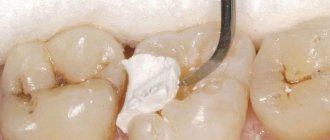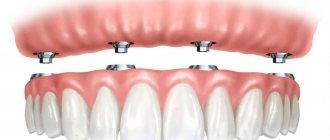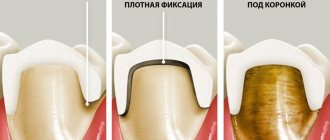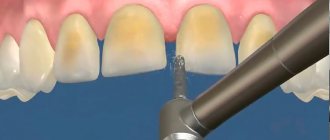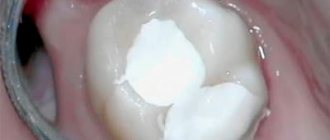Tooth filling is one of the most common and well-established dental procedures, however, it also has its own nuances and subtleties. We tell you what you should pay attention to, what filling to choose and how the filling is installed on a tooth at the ViDentis clinic.
Almost every person has had to deal with a tooth filling in their life. This is a simple and effective procedure, which consists of removing damaged areas of enamel and its further restoration using special compounds. The cost of installing a filling is low, so this treatment is used quite often.
Why do you need dental filling?
The first experiments with the installation of fillings were carried out before our era. Holes in the teeth were filled with resin and various mixtures. However, the archaic technique of filling teeth brought almost no positive results. Fortunately, today everything has changed dramatically. Modern fillings are successfully used to perform a variety of tasks, in particular for:
- functional filling
- aesthetic dental filling
- filling root canals
- temporary sealing of a damaged tooth
Possible complications
Complications after filling occur if the doctor did not properly clean the tooth cavity of caries. This can lead to a recurrence of the lesion, which will then pass under the filling and go unnoticed. As a result, significant damage to the tooth can occur.
Another complication is associated with breaking off the edges of the tooth after the filling shrinks. To avoid it, the doctor must carefully remove all overhanging edges of the enamel.
Also, in case of poor-quality grinding, the patient may experience overbite, which will lead to significant discomfort. However, this problem can be solved very quickly by visiting the doctor again.
The iOrtho clinic network provides high-quality services for correcting malocclusion with Invisalign aligners, sign up for a consultation now!
Types of dental fillings
Classic filling of carious teeth involves the installation of a dental filling without depulpation of the root canals. This technique is used for minor mechanical and carious damage to the tooth (superficial and medium caries) and is carried out in several stages.
When the dental pulp is damaged, in most cases it is necessary to fill the root canals of the teeth. In the case of milk and young molars, there are methods for preserving the functionality of the root - a biological method of treatment using calcium-containing preparations (tooth filling with calcium) or partial amputation of the pulp. This allows you to maintain the blood supply to the tooth and its vitality, which is especially important when it is in the development stage.
Depulpation involves removing the tooth root, cleaning and developing the canals with special instruments and filling them with artificial materials in order to eliminate the risk of developing inflammatory processes. There are various methods of root canal treatment. There is no absolutely ideal method, so the doctor focuses on a specific clinical case.
Stages and technology
Today, they no longer remove a diseased tooth, but treat it. In case of caries, the doctor fills it. The service life of such a tooth will directly depend on the professionalism of the specialist and the quality of the material used.
Pain may occur during the procedure because the pulp contains nerve endings that immediately send a signal to the brain. But today there are many anesthetics that make the patient feel no pain.
If we talk about filling technology, it is divided into several stages:
- Initially, an anesthetic injection is given to relieve pain;
- carefully process, clean the area of the tooth that has been damaged by caries. If the pulp is inflamed, it is removed, after which the cavity is disinfected. If there are small areas of affected tissue under the filling, the inflammatory process will begin again;
- In case of minor damage to the teeth, a medical lining is placed. If the process is started, then the pins are installed;
- the material is selected, it all depends on several factors;
- An x-ray is taken to look at the result and make sure that the affected areas have been completely removed;
- The composite is sanded, and the filling is then coated with indelible varnish.
Dental filling methods
All methods of filling teeth are based on the use of various materials, which have their own advantages and disadvantages. Therefore, when choosing a technology, the doctor focuses on the individual characteristics of the structure of the root canals and the patient’s body as a whole.
Filling teeth with gutta-percha
Removal of the nerve of the tooth and filling of the canals, when the cavity is filled with a special paste based on gutta-percha with the addition of various impurities. Despite its simplicity and relatively low cost, this method of filling teeth cannot be called reliable and safe. It is often accompanied by a violation of tightness, the development of inflammation and allergic reactions.
Using a pin
Filling a pulpless tooth with pins is one of the most common techniques in dentistry. There are two types of pins (fillers): gutta-percha and metal. Filling tooth canals with gutta-percha is considered a more reliable and safe method. Even taking into account the presence of polymers, dyes and metal salts, such pins are biocompatible and do not cause allergies. Silver metal structures have good flexibility and can be installed in long and curved channels, however, silver is prone to oxidation, which can lead to inflammation. Titanium posts are better in terms of tissue compatibility, but they are very rigid and require the preparation of a special bed, which makes the tooth walls extremely fragile.
Sealers-sealers
Even gutta-percha pins for filling the root canals of teeth by themselves are not able to provide a reliable result, since they do not have antibacterial properties. To improve the quality of filling, dentists use sealers - sealants that ensure a tight fit of the material to the canal walls. There are natural (based on cement, zinc oxide, etc.), polymer sealers, glass ionomer cements and pastes based on calcium hydroxide.
Complex dentistry "Sanident" in Shchelkovo
Modern dentistry "Sanident" provides services for dental treatment, restoration and elimination of various defects in the oral cavity. Highly qualified specialists, an integrated approach to treatment, high-quality equipment and modern technologies make the treatment process as comfortable, safe and painless as possible for the patient.
All instruments undergo thorough disinfection; sterility is required in the dentist’s office. This helps prevent the occurrence of various infections. Human health comes first for us.
You can find the Sanident clinic in the city of Shchelkovo, Moscow region, on Tsentralnaya Street, building 80 (Voronok railway station). The dentistry is easily accessible both by public transport and by private car, because it is located in the very center of the city.
Teeth filling process
- Initial consultation, taking x-rays.
- Coordination of treatment methods and selection of the type of fillings to be installed.
- Anesthesia before therapeutic intervention (local anesthesia, sedation, in rare cases - general anesthesia).
- Preparation of damaged or caries-affected tooth tissues.
- Grinding and processing the surface of the filling for proper closure.
Filling temporary teeth (baby teeth) follows the same plan, however, in pediatric dentistry, more compatible and safe materials are used.
Chemically cured composites
The main property of chemically cured composites for fillings is their polymerization exclusively when exposed to certain substances. That is, such materials harden evenly after mixing their original components. This makes the filling process more controlled and of high quality, especially when it comes to very deep cavities or extensive carious lesions.
The disadvantages of this material for fillings include the following:
- insufficient resistance, especially under systematic mechanical influence;
- rapid pigmentation and high probability of darkening.
In this regard, such fillings are used less frequently compared to photopolymers.
Filling of anterior teeth
In the case of front teeth, the aesthetic aspect comes to the fore, so the filling material must have the appropriate properties. Although the front teeth receive better hygiene due to their accessibility, they are also susceptible to caries. Installing a filling on the front teeth is considered a more complex procedure: it is necessary not only to give the filling the desired shape, but also to choose the right color. In most cases, filling of anterior teeth is carried out using compomers, as well as light composite fillings, which harden under the influence of ultraviolet radiation. Be that as it may, in case of serious damage, it is impossible to achieve good aesthetics with the help of filling, so you often have to turn to orthopedic solutions.
Is it painful to have a filling?
Modern medicine has made great progress to make patients feel comfortable being treated. Therefore, today few people are afraid to go to a specialist and have their teeth treated.
You can also choose any anesthetic to remove the hellish pain that people used to feel during the treatment of dental caries. Moreover, the choice is so large that even an allergy sufferer can choose the right material. Just a few injections into the gum area and the patient does not feel pain for some time. There is only slight sensitivity after the procedure, but it will go away after 2 days.
Installing a seal on a pin
More recently, it has become common practice in dentistry to install a filling on a post if the tooth is more than 50% destroyed. Thus, the technique made it possible to avoid prosthetics. Filling a tooth with a pin must be preceded by removal of the nerve. Then a special screw is inserted into the root canal and fixed with cement. The procedure is completed by layer-by-layer application of light-polymer composite materials. However, installing a pin does not guarantee reliability and safety. Over time, the cement breaks down, causing microbes to get under the filling, causing the formation of caries. Having chosen modern dentistry to install a filling, you are unlikely to encounter such technology.
Can I put a filling myself?
Having sufficient skills in the field of dentistry, you can install a filling yourself, while at home. Of course, this way you can provide protection when you urgently need to get rid of pain. However, if the tooth canal is affected by carious destruction, then it is not recommended to do the procedure yourself; it is better to contact a dental clinic.
To get rid of unpleasant sensations, the affected area needs to be treated. After alcohol treatment and temporary filling, you will have to visit the dentist immediately. When carrying out all manipulations, it is important to carefully ensure that caries does not prevent the filling composition from adhering to the dental tissue.
What do you need to make a filling at home?
As a composition from which you can make your own filling, a special powder is often used, sold at any pharmacy. There are also many filling kits on the market, the set of which, in addition to the material, includes a special spatula, as well as an oxidizing substance required for the initial treatment of enamel.
Permanent silver, metal or composite ones cannot be reproduced on your own. How long will it take to fill a hole at home? If you have experience and the necessary literature, you can fill up a sore tooth with your own hands in an hour to an hour and a half.
Types of filling materials
| Material type | Varieties | Description |
| Cement | – Zinc phosphate – Silicate – Glass ionomer | Currently, of all types of cement fillings, only glass ionomer fillings are actively used, since they provide good mechanical and chemical bonding with tooth tissues. Zinc-phosphate fillings tend to shrink, so they are almost never used when filling teeth for caries. Silicate materials are considered toxic and also have restrictions in their use. |
| Metal | – Gold – Copper – Silver | They are distinguished by high quality and a very large margin of safety. On the other hand, amalgam fillings shrink over time and are not always airtight, which can lead to the development of secondary caries. Due to low aesthetic indicators, they are used for filling chewing teeth. |
| Composite materials | – Acrylic – Epoxy – Light-curing – Chemical-curing | Composite fillings are obtained by mixing organic and inorganic elements. Due to the noticeable disadvantages of filling teeth with composite materials (rapid wear and toxicity for acrylic ones, fragility for epoxy ones), the first two types of fillings are practically not used. Light-curing composites are considered the best: they quickly harden under the influence of ultraviolet radiation and can be used in any part of the jaw. The procedure is often called light dental filling. |
| Compomer | It is a kind of hybrid of glass ionomer and composite | Very aesthetic and high-quality fillings, which are most often used in the frontal region when restoring teeth after chips. Their only drawback is fragility. |
| Materials for temporary fillings | – Artificial dentin – Soft dentin paste – Cariosan (cement) – Vinoxol (zinc oxide based) | They are often placed during pulpitis to check the reaction of the tooth, as well as after filling root canals until a permanent filling is installed. Temporary fillings are also used when filling a tooth under a crown. |
Types of fillings by service life
Depending on the period during which the fillings are in the tooth cavity, they are divided into two types - temporary and permanent. They differ from each other in the material from which they are made, and also have different appearance.
Temporary
Temporary tooth fillings are used when treatment is carried out in two stages. At the first of them, the doctor cleans the cavity from caries. Next, it is necessary to place special medications into the tooth that disinfect the tissues or promote the death of the dental nerve. This approach is needed in case of deep caries damage or the presence of its complications, for example, periodontitis.
Temporary fillings are also needed if additional time is needed to make a permanent one. Certain types of fillings are made in a laboratory using impressions that are taken from a cleaned cavity. At the same time, at the first appointment with the doctor, a temporary material is installed, and at the next one he can install a permanent one.
Permanent
Permanent fillings are installed during one-stage treatment of caries. In this case, at the first appointment, the doctor cleans the affected cavity and places a permanent filling in it. This method is suitable if we are talking about superficial or medium caries.
How much does the procedure cost?
The exact cost of dental filling is usually announced by the doctor at the initial consultation. The price will depend on the filling material used and the amount of work. Filling canals will cost more than simply installing a filling.
| Type of filling | Price |
| Cement filling | From 900 rubles |
| Glass ionomer filling | From 1,500 rubles |
| Filling made from a light-curing composite of the latest generation | From 3,500 rubles |
| Filling made from a chemocurable composite of the latest generation | From 2,500 rubles |
